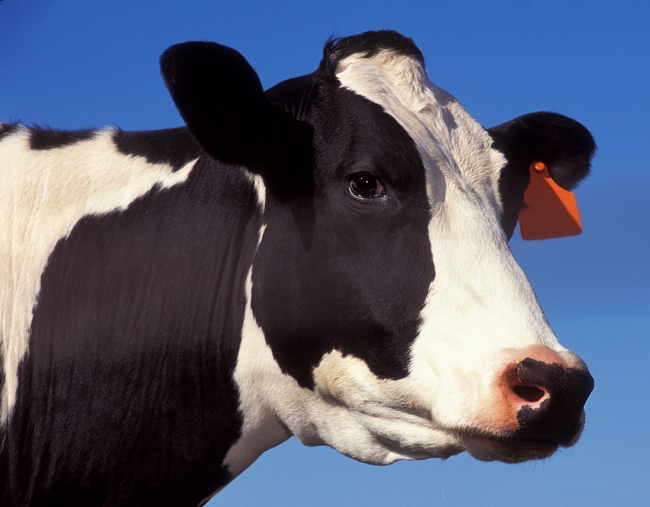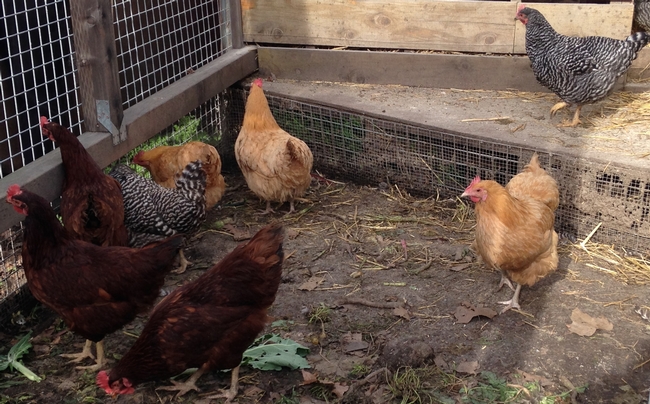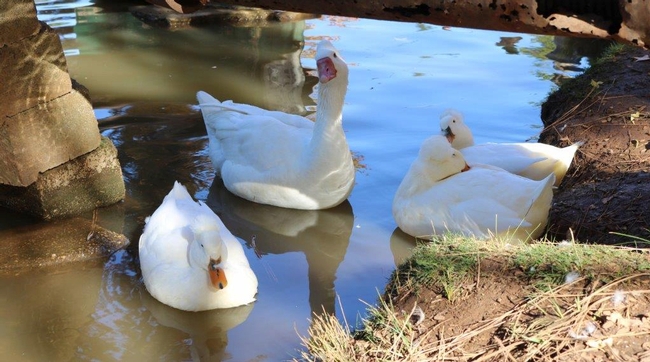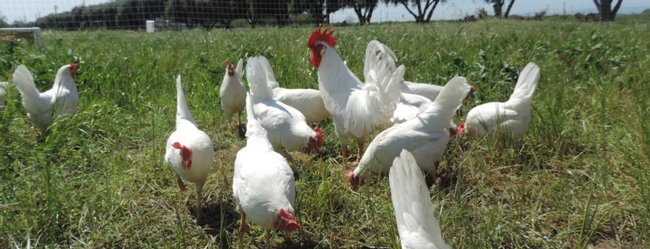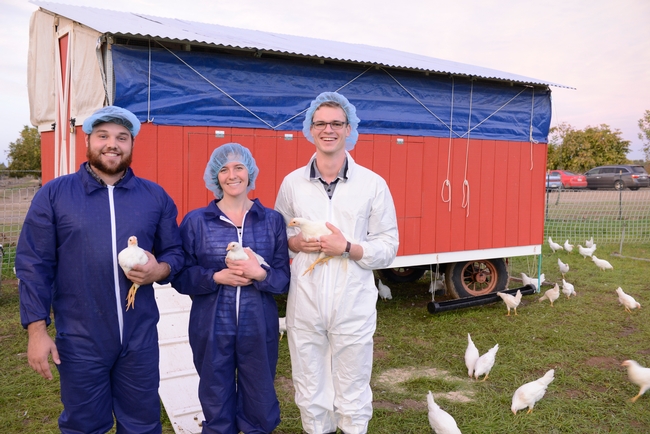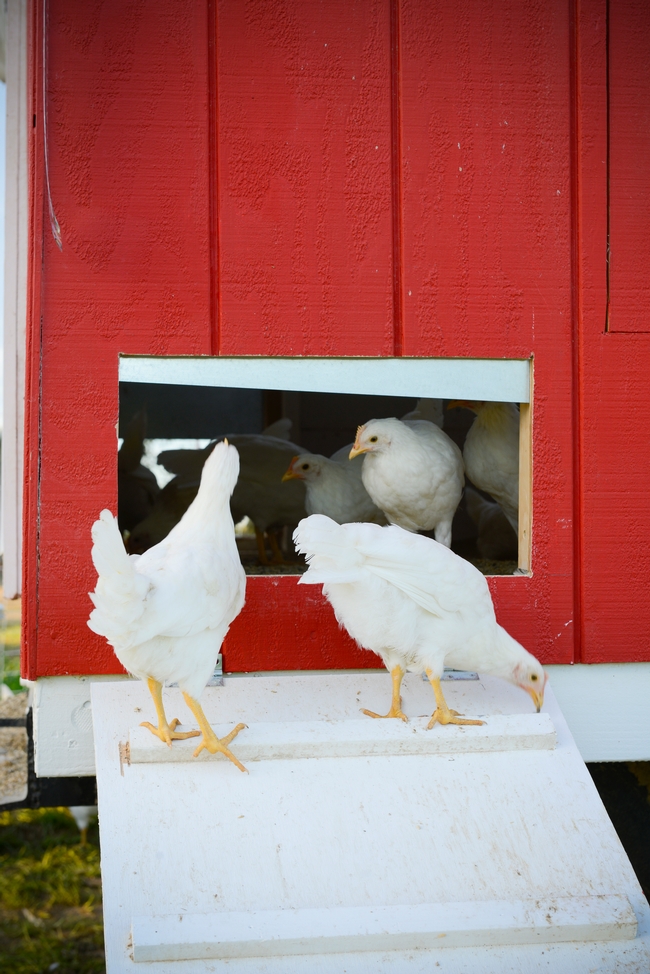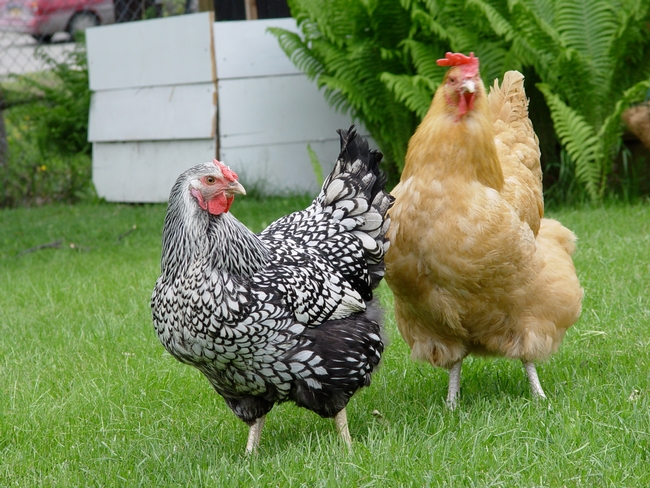Posts Tagged: Veterinary Medicine
UC helps California dairy farmers experiment with milking robots
The technological developments were critical to the formation of California's enormous dairy industry, the largest in the nation. Today, more than 1.7 million cows produce 39.8 billion pounds of milk in California each year, according to the California Milk Advisory Board.
The march of progress continues. The state's dairy industry is now beginning to integrate robots and sophisticated computer software into cow barns to maintain the supply of wholesome and inexpensive dairy foods for Americans. UC Cooperative Extension scientists are poised to help them adapt to the new technologies.
On most California dairies, cows are led two or three times each day from the barn to the milking parlor by workers. They clean the cows' udders to remove bacteria and surface dirt, evaluate whether the cow has mastitis, attach the milking machines, and disinfect the cow's teats after milking before taking the cows back to their pens.
“Dairy production is automated, but it is still a very labor intensive activity,” said Fernanda Ferreira, UC Cooperative Extension dairy specialist based at the UC Veterinary Medicine Teaching and Research Center in Tulare. “Farmers always tell us that the most challenging thing they are facing is labor – labor availability, training and cost.”
Milking robots – a technology already being used in dairies in the Midwest and Eastern U.S., Europe, South America and Canada – promises greater automation, reduced labor needs and improved animal welfare.
View a short video clip of the milking robot in action.
The machines don't resemble a stereotypical robot character, but rather are computerized boxes large enough to fit one cow, with a robot arm programmed to reach under the cow and clamp onto the teats. Cows do not need to be led to the milking machine, but rather walk into the box voluntarily when they are ready to be milked.
The machine recognizes each individual cow by a computer tag around her neck or on the ear, and provides personalized milking service. The robots do all the work: clean the teats, attach the milking machines, and disinfect the teats after the milking is done. While milking, the robot collects data on the cow's output and health.
When it comes to California and all the West, these are very new,” Ferreira said. “We're talking herds that have 1,800 cows on average. Huge herds. Since each of the robotic units, which serve 60 to 70 cows, costs about $120,000, we're also talking about a huge investment.”
Two San Joaquin Valley dairies have already installed milking robots, and many others are interested in the new technology. Ferreira and other researchers from the VMTRC in Tulare are collaborating with one of them to study how the machine and the herd's management can be adapted to better serve large-scale dairy herds like those in California.
“Our idea is to first understand the perspective of the producers who have cows being milked by robots. We want to know what they have learned so far, the challenges they have encountered, their relationship with banks,” Ferreira said. “Relationships with banks are important because most dairies will need to borrow funds to equip their facilities with enough robots for full automation.”
Future research will review issues of milk quality, mastitis management and determine what data farmers will need from the computerized system to improve dairy profitability.
“There are a lot of options available from companies that manufacture the robots. We want to fully understand how they work for our farmers and cows to be able to inform the future of California's dairy industry,” Ferreira said.
Backyard poultry enthusiasts invited to participate in UC research survey
Californians who raise backyard poultry are invited to participate in a study to help the University of California more effectively deliver poultry health information, especially to prevent the spread of poultry diseases.
The UC Davis School of Veterinary Medicine and UC Davis Veterinary Medicine Cooperative Extension are conducting a research study consisting of a voluntary survey designed specifically for backyard poultry owners in California.
“Our goal is to better understand how backyard poultry enthusiasts communicate with each other in California and to design and execute effective and efficient backyard poultry outreach programs,” said Maurice Pitesky, UC Cooperative Extension poultry specialist with the UC Davis School of Veterinary Medicine. “To do this, we are sending out a short survey to help us understand the ‘structure' of the backyard poultry network."
This information will be crucial in the event of a poultry disease outbreak such as avian influenza.
For example, if the researchers know which counties have a large number of birds traveling in and out, then they can focus outreach resources, such as biosecurity workshops, in those higher-risk counties. In addition, the information will guide UC scientists to plan custom workshops depending on the needs of poultry owners in specific counties.
“Please note we are a university not a regulatory agency and therefore our focus is on outreach and education, not regulation and enforcement,” Pitesky said.
If you would like to participate in this voluntary study, please fill out the California Backyard Poultry Survey at http://ucanr.edu/sites/poultry/CA_Backyard_Poultry_Survey by June 1, 2017.
If you have any questions or comments, please contact UC Cooperative Extension specialist Pitesky at mepitesky@ucdavis.edu or his research associate Myrna Cadena at mmcadena@ucdavis.edu.
Are your birds safe from avian influenza?
To prevent outbreaks of this highly contagious virus in the United States, commercial and backyard poultry owners are being asked to fill out an online biosecurity survey. UC Agriculture and Natural Resources and UC Davis researchers are studying poultry-raising practices to help strengthen the industry's defenses against avian influenza.
“With changing migration patterns of wild birds and global movements of poultry, there is an urgent need to develop plans to protect U.S. poultry against highly pathogenic avian influenza,” said Beatriz Martínez López, director of the Center for Animal Disease Modeling and Surveillance in the School of Veterinary Medicine at UC Davis.
People who raise chickens, quail, ducks, turkeys, geese or other birds anywhere in the United States are invited to fill out the survey.
“We want to hear from all poultry producers: from the large commercial farms producing chicken eggs to the poultry enthusiasts who raise a few ornamental show birds in their backyards,” said Martínez López, who is part of the University of California's Agricultural Experiment Station.
The survey asks which bird species are being raised and a few flock management questions. Is the flock is housed or kept outdoors? How often do you get new birds? What is the source of new birds? It also asks questions about location, such as the distance of the birds from ponds and other bodies of water that may attract migrating waterfowl.
Immediately after completing the online survey, participants receive a biosecurity score and recommendations to help them make more informed decisions.
“Each producer will receive their own biosecurity score and customized recommendations,” Martínez López said. “Recommendations highly depend on the production system and we tried to adapt them to make the changes easier to implement for individual flocks.”
The survey data will be confidential and only summaries will be made publicly available in research reports and peer-reviewed publications.
By analyzing biosecurity and management practices on poultry operations and backyard flocks, Martínez López and visiting professor Sharmin Chowdhury will be able to identify high-risk locations and time periods for avian flu outbreaks. The information will be used to develop biosecurity education programs for poultry farmers, backyard producers and poultry veterinarians.
The survey takes about 15-20 minutes to complete. To participate, take the survey in English http://bit.ly/2kkMycf or Spanish http://bit.ly/2mjO13G by June 1.
This study is funded by Agriculture and Food Research Initiative Competitive Grant no. 2015–09118 from the USDA National Institute of Food and Agriculture.
[This news release has been updated to extend the survey deadline from March 1 to June 1 and to include a link to the survey in Spanish.]
MEDIA CONTACT:
Beatriz Martinez López, DVM, beamartinezlopez@ucdavis.edu, (530)752-7675.
Pastured poultry farm to foster innovation for small chicken farms
UC Agriculture and Natural Resources (UC ANR) provided seed money to launch a new Pastured Poultry Farm at UC Davis. The farm is home to 150 young chickens and a living laboratory where students and faculty researchers hope to develop innovative solutions benefiting pasture-based farms, integrative crop-and-poultry farms and backyard flocks.
Pasture-based chicken production offers many benefits as well as some challenges in terms of food safety, animal health and welfare, and environmental impacts, said Maurice Pitesky, UC ANR Cooperative Extension poultry specialist with the School of Veterinary Medicine and co-leader of the poultry project.
The new 4.5-acre farm, located about one mile west of the central UC Davis campus, includes a seeded, irrigated pasture, where the chickens can forage. In the center is a bright red student-built Eggmobile for night time housing. The ‘coop on wheels' can be strategically moved around the land for consistent fertilization. The pasture uses a portable electronic fence to protect against predators and is surrounded by a 50-foot band of uncultivated land to serve as a wildlife buffer.
“This is a unique innovation, research and outreach resource for the Western United States,” Pitesky said. “The project includes faculty and students with expertise in veterinary medicine, husbandry, welfare, pasture management and engineering, which allows us to address issues related to predator control, welfare, food safety and food efficiency.”
Debbie Niemeier, professor in the Department of Civil and Environmental Engineering, and her team have already developed a number of innovations for the project, including a tarp-pulley system, portable-shade and predator-mitigation structures, an automatic watering system, and modular roll-out nest boxes.
One of the advantages of the pasture-based system is the opportunity for a farmer to integrate chicken production with a farm's existing cropping system, with the chickens providing natural fertilizer for the crops.
“It's also a way for crop farmers to move into poultry production without expanding their land or adding nitrogen fertilizer to their farming system,” Pitesky said.
The new project is largely driven by students - drawn from the School of Veterinary Medicine, College of Engineering, and College of Agricultural and Environmental Sciences - who designed and constructed the Eggmobile. The mobile barn includes 32 nest boxes, each capable of accommodating several chickens. As it is moved to different locations in the pasture, chicken droppings gradually fertilize the grass. The student and faculty research teams will be delving into issues involving diseases and chicken health, predation by wildlife, and occupational health for workers.
Eggs produced by the project's flock will initially be donated to food shelters. The potential for eventual egg sales to the community is being explored. Eventually, the research team hopes to construct multiple Eggmobiles with different designs, and in time would like to expand the project to include broiler chickens, as well as cropping systems that integrate poultry, in order to fully maximize the potential of the land for food production.
A list of donors and other information about the UC Davis Pastured Poultry Farm can be found online. The School of Veterinary Medicine has established an online site where individuals interesting in supporting the UC Davis Pastured Poultry Farm financially can make donations.
Author: Patricia Bailey
Reduce the risk of bird flu in backyard chickens
Protecting their birds against disease should be a priority for chicken owners, no matter what size the flock, according to Maurice Pitesky, a UC Agriculture and Natural Resources Cooperative Extension specialist in the School of Veterinary Medicine at UC Davis.
“Wild birds are the biggest risk because they can carry the virus but look completely healthy, so it's important to keep them away from your chickens,” said Pitesky. He adds that signs your chicken could have contracted avian influenza are depression, no appetite, diarrhea, soft/misshaped eggs, and sudden and increased or unexplained death in flocks.
Commonly called “bird flu,” the avian influenza virus - routinely found in wild waterfowl - can spread to chickens and other domestic poultry and cause significant mortality and economic loss. This year the nation has experienced the worst bird flu outbreak in history, with three confirmed cases in California — two of which carried the more dangerous, highly pathogenic strain. In each case, the disease, which is not dangerous to humans, was introduced by wild waterfowl migrating along the Pacific Flyway. Some of these wild birds might now be carrying the Eurasian strain of the H5 highly pathogenic avian influenza.
Pitesky and the California Department of Food and Agriculture offer some important bioscurity tips to help reduce the risk of your chickens contracting bird flu:
- Wash your hands with soap and water or use hand sanitizer before and after working with chickens.
- Use footbaths before entering and exiting the fenced-off coop area. Each footbath — a covered container with an approved disinfectant to disinfect shoes — should be placed in a staging station, such as on a concrete surface or a pallet, to prevent dirt from being tracked into the footbath. Disinfectant should be changed daily to be effective.
- Have designated “coop boots.” These will be the only shoes that go into your chicken area, and they won't go anywhere else. If you hunt waterfowl, make sure your equipment and clothing are separate from your domestic poultry.
- Don't allow wild animals and waterfowl to come in contact with your chickens. For example, if you have a pond or body of water that can attract waterfowl to or near your facility, consider draining if feasible.
- When obtaining birds, isolate them from other birds for 30 days before adding them into your flock. This will reduce the risk of introducing disease into the original flock.
- Always obtain birds from reputable, disease-free sources that practice good biosecurity methods, and purchase feed from clean, dependable suppliers. Store the feed in containers that are bird, rodent, and insect proof. Provide clean, fresh water to your birds at all times.
- Restrict access by visitors onto the premises where your birds are housed. Do not allow people who own other birds to come in contact with your birds.
- Report signs of illness or increased mortality to your veterinarian or the Sick Bird Hotline 866-922-BIRD (2473). In addition, necropsies are provided free-of-charge for owners of less than 1,000 chickens at the school's California Animal Health and Food Safety Laboratory System.
By joining the California Poultry Census, you can receive the latest information and updates about avian influenza in California.
Early disease detection, prevention key to limiting spread of disease
State officials credit early disease detection and prevention, through proactive surveillance and good biosecurity practices, as key factors limiting the spread of avian influenza. For example, a wildlife surveillance program conducted by USDA Wildlife Services regularly submits samples to the veterinary school's California Animal Health and Food Safety Laboratory System at UC Davis for testing. This helps scientists and animal health officials understand where certain viruses are circulating in the U.S., including the more dangerous strains for domestic poultry.
UC poultry experts are conducting a statewide survey of backyard chickens, and providing outreach and training on health and disease prevention to individuals who, in turn, will provide the information to backyard chicken producers and small, commercial chicken operations. In addition, veterinary researchers Rodrigo Gallardo and Beate Crossley have recently been awarded a grant to study new, highly pathogenic viruses affecting the U.S. poultry industry. The goal is to better understand why these viruses have been so difficult to eradicate and to help prevent their introduction to commercial farms.
Additional information:
- University of California Cooperative Extension Poultry Resources
- CDFA Backyard Biosecurity for Poultry
- USDA Backyard Biosecurity

